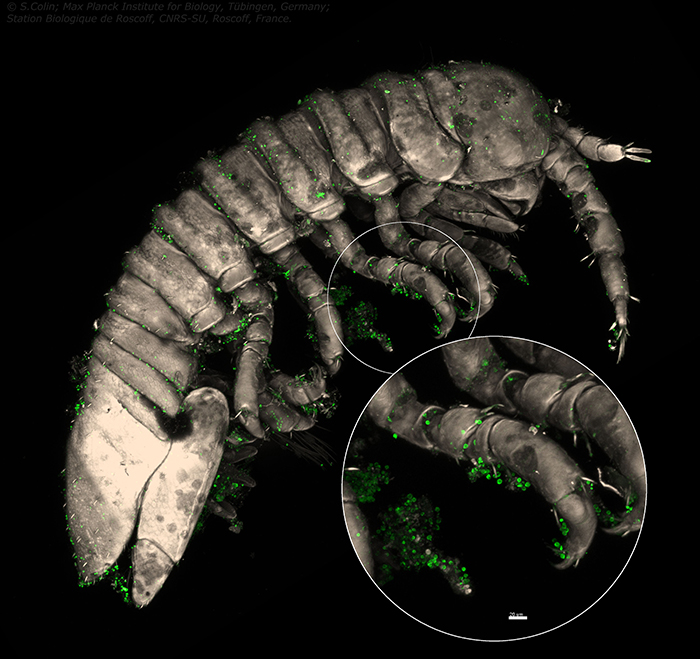Because of the way things can drift around in water, a lot of different aquatic organisms use a sort of “immersion” strategy for reproduction. Rather than going through all the bother of finding a mate and copulating, they just produce such massive amounts of gametic material that it’s guaranteed to encounter its target, just drifting around. This is particularly a good strategy for species that are either stuck to the sea floor, or that are themselves drifting without direction. Another version with which you’re probably familiar is the clouds of pollen released by trees and some other plants in the spring.
I had long assumed – and I wasn’t alone in this – that aquatic plants of all sorts relied on this dispersal method. It seems obvious, right? With water being an ever-present resource, why would any sort of “pollinator” relationship develop? Well, as always with evolution, the adaptations that provide immediate, short-term benefits are the ones most likely to stick around.
In this case, it turns out that red algae “pollen” is a bit sticky (as gametes are wont to be), and there are tiny creatures that make their living on and around the algae in question:
Are sea animals involved in the reproductive cycle of algae, like pollinating insects on dry land? Dispersal of the male gametes, or spermatia, of red algae generally relies on water movement, and up until now, scientists did not recognize the role played by animals.
Yet an international team led by Myriam Valero, a CNRS scientist affiliated with the Evolutionary Biology and Ecology of Algae research unit (CNRS / Pontificia Universidad Católica de Chile / Sorbonne University / Universidad Austral de Chile) and Roscoff Marine Station (CNRS / Sorbonne University)1 , has revealed that tiny marine creatures called idoteas act as ‘sea bees’ for the red alga Gracilaria gracilis.

The image is a black and white microscope photograph of an Idotea isopod. It has a segmented body, with at least eight legs. It’s shaped a bit like a pill bug or a prawn – longer than it is wide, with what appears to be two long, thick, segmented antennae on its head. The only color in the photo is little green dots, highlighting the places where algal gametes are stick to the Idotea’s exoskeleton. There’s a circle around two of its legs, corresponding to a zoomed-in circular photo showing a more detailed image of the Idotea’s clawed feet, and the “pollen” dusting them.
Idoteas contribute to the fertilization of G. gracilis as they swim amid these algae. The surfaces of the male algae are dotted with reproductive structures that produce spermatia coated with mucilage, a sticky substance. As an idotea passes by, the spermatia adhere to its cuticle and are then deposited on the thalli of any female alga the crustacean comes into contact, thus helping G. gracilis reproduction.
But idoteas also stand to benefit in this arrangement. The seaweed gives them room and board: idotea cling to the algae as a protection from strong currents, and they munch on small organisms growing on their thalli. This is an example of a mutualistic interaction—a win-win situation for plant and animal alike—and the first time that an interaction of this kind between a seaweed and an animal has been observed.
While these initial findings do not indicate the extent to which animal transport of gametes contributes to algal fertilization relative to the role of water movement—previously thought to be the sole means of gamete dispersal—they do offer surprising insight into the origin of animal-mediated fertilization of plants. Before this discovery, the latter was assumed to have emerged among terrestrial plants 140 million years ago. Red algae arose over 800 million years ago and their fertilization via animal intermediaries may long predate the origin of pollination on land. Valero’s team now aim to focus on several other questions: Do idoteas trigger the release of spermatia? Are they able to distinguish male G. gracilis algae from female individuals? And most importantly, do similar interactions exist between other marine species?
First off, I just want to appreciate the way the authors take time to flesh out the historical implications of this discovery. Underwater ecosystems, as far as I know, tend not to have plants that evolve organs specifically to attract animals as pollinators. I could imagine a number of reasons for this, but at the same time, I could imagine reasons why it might not be a beneficial strategy on land. For one, if the current decline in insect populations continues, wind-pollinated plants are probably going to fare a bit better in the coming century or two.
Part of me wants to assume that if there were underwater organisms that used something like scent to attract “pollinators”, we’d have noticed that behavior in the animal in question. That said, our oceans are vast, treacherous deserts, with brutal, unyielding conditions that make study extremely difficult and dangerous at times. At the end of the day, I love reminders that there’s still so much to discover, and when I get a chance to throw in a fun pun for the title, well, that’s just the sea bee’s knees!
If you like the content of this blog, please share it around. If you like the blog and you have the means, please consider joining my lovely patrons in paying for the work that goes into it. Due to my immigration status, I’m currently prohibited from conventional wage labor, so for the next couple years at least this is going to be my only source of income. You can sign up for as little as $1 per month (though more is obviously welcome), to help us make ends meet – every little bit counts!
